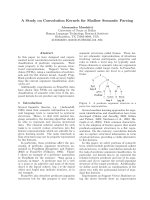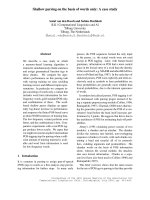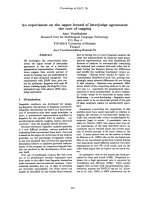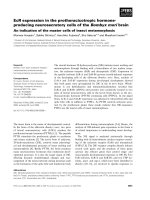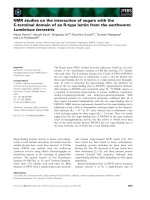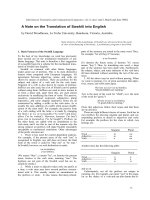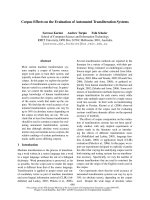Báo cáo khoa học: "Comparative study on the aflatoxin B1 degradation ability of rumen fluid from Holstein steers and Korean native goats" pot
Bạn đang xem bản rút gọn của tài liệu. Xem và tải ngay bản đầy đủ của tài liệu tại đây (312.21 KB, 6 trang )
JOURNAL OF
Veterinary
Science
J. Vet. Sci. (2009), 10(1), 29
34
DOI: 10.4142/jvs.2009.10.1.29
*Corresponding author
Tel: +82-2-880-4809; Fax: +82-2-875-8710
E-mail :
Comparative study on the aflatoxin B1 degradation ability of rumen
fluid from Holstein steers and Korean native goats
Santi Devi Upadhaya
1
, Ha Guyn Sung
2
, Chan Hee Lee
1
, Se Young Lee
1
, Sun Woo Kim
1
, Kyung Jin Cho
3
, Jong
K. Ha
1,
*
1
Department of Agricultural Biotechnology, Research Institute for Agriculture and Life Sciences, College of Agriculture and
Life Science, Seoul National University, Seoul 151-921, Korea
2
Daeho Tech, Hwasung 445-933, Korea
3
GeneBio Tech, Gongju 314-831, Korea
The aflatoxin B1 degrading abilities of two different
ruminants were compared in this study. One set of
experiments evaluated the aflatoxin B1 degradation ability
of different rumen fluid donors (steers vs. goats) as well as
the rumen fluid filtration method (cheese cloth filtered vs.
0.45
μ
m Millipore) in a 2
×
2 factorial arrangement.
Additional studies examined aflatoxin B1 degradation by
collecting rumen fluid at different times (0, 3, 6, 9 and 12 h)
after feeding. Cannulated Holstein steers (740
±
10 kg bw)
and Korean native goats (26
±
3 kg bw) were fed a 60%
timothy and 40% commercial diet with free access to water.
Rumen fluid from Korean native goats demonstrated higher
(p
<
0.01) aflatoxin B1 degradability than Holstein steers.
However, filtration method had no significant influence on
degradability. In addition, aflatoxin degradation did not
depend upon rumen fluid collection time after feeding, as no
significant differences were observed. Finally, a comparison
of two types of diet high in roughage found aflatoxin
degradability in goats was higher with timothy hay opposed
to rice straw, although individual variation existed. Thus, our
findings showed the aflatoxin degradability is comparatively
higher in goats compared to steers.
Keywords:
aflatoxin B1, degradation, ELISA, rumen
Introduction
Aflatoxin is one of several extremely toxic, mutagenic
and carcinogenic compounds produced by Aspergillus (A.)
flavus and A. parasiticus [6]. Research studies have
revealed four major aflatoxins; B1, B2, G1 and G2 as well
as two additional metabolic products, M1 and M2, that are
direct contaminants of foods and livestock feed. Of these,
aflatoxin B1 (AFB1) is the most prevalent and toxic for
both animals and humans [17].
Aflatoxin interferes with disease resistance and vaccine-
induced immunity in livestock [7], exemplified by immunity
suppression by AFB1 observed in turkeys, chickens, pigs,
mice, guinea pigs, and rabbits [22]. Symptoms of acute
aflatoxicosis in mammals include inappetence, lethargy,
ataxia, rough hair coat, and enlarged pale fatty livers. In
contrast, chronic aflatoxicosis exhibits symptoms including
reduced feed efficiency and milk production, icterus, and
decreased appetite [18]. Reduced growth rate is possibly
the most obvious indication for chronic aflatoxicosis and
other mycotoxicoses [20] and is related to disturbances in
protein, carbohydrate and lipid metabolism [3].
Aflatoxins have been detected in numerous agricultural
commodities such as cereal grains, oilseeds, cotton seeds,
wheat, corn, peanuts and dried fruits as well as in animal
feed and various dairy products [19]. The toxin becomes
stable once formed in grain, resistant to degradation during
normal milling and storage [2]. This presents the toxicity
of contaminated feed stuffs as a significant, potential health
hazard to animals and human beings.
Several strategies for the decontamination/detoxification
of grains contaminated by mycotoxins have been reported
using physical, chemical and biological methods specific
to the commodity. However, previous treatments have
exhibited limitations due to considerations for safety, which
require not only the treated products be unaffected by the
chemicals used, but also that their essential nutritive values
be maintained [16]. A study by Wang et al. [23] found
adsorbents like activated charcoal and hydrated sodium
aluminum silicates at low percentage were ineffective
when used to treat moldy feed. It was observed a high
percentage of adsorbents bind essential nutrients, causing
negative effects.
30 Santi Devi Upadhaya et al.
The application of enzymes or microorganisms capable
of biotransforming mycotoxins into nontoxic metabolites
has emerged as an alternative strategy in controlling
mycotoxicoses in animals. Microbes transform mycotoxins
in the intestinal tract of animals prior to absorption.
Biotransformation, the cleavage and detoxification of
mycotoxin molecules by microbes or enzymes, is an
effective and safer method for mycotoxin control [21].
Several mycotoxins and plant toxins have been shown
previously to be detoxified by rumen microbes, ochratoxin
A (OTA) [9] and AFB1 [1] among the first. Jones et al. [10]
reported the disappearance of AFB1 within several weeks
of incubation with broiler and turkey faeces. Karlovsky
[13] reported a 42% degradation of aflatoxin when incubated
in vitro with rumen fluid. The ability of ruminants to
metabolize selected mycotoxins has also been investigated
[14]. It was found the mycotoxins zearalenone (ZON),
trichothecenes mycotoxin (T-2 toxin), diacetoxyscirpenol
and deoxynivalenol were well-metabolized by whole
rumen fluid, whereas AFB1 and OTA were not. Westlake
et al. [24] investigated the effects of these mycotoxins
along with Verrucarin A on the growth rate of Butyrivibrio
(B.) fibrisolvens specifically. They found this organism
degraded all tested mycotoxins except AFB1, and that
growth of B. fibrisolvens was not inhibited. Kurmanov [15]
previously reported ruminants are more resistant to
mycotoxin poisoning than monogastrics, which implies
livestock are not equally affected by other toxins as well. In
vitro rumen fermentation studies on the plant toxin
pyrrolizidine alkaloid (PA) showed a higher degradation
ability in sheep and goat than cattle [4,8]. Likewise,
animals fed tansy ragwort containing PA demonstrated
vastly different quantities of plant material required to
manifest clinical symptoms. The consumption at the rate of
more than 200% of the body weight of sheep and goat,
4-10% of the body weight of cattle and horse and 5% of the
body weight of chicken was required to show clinical signs
[5,8].
In this study, aflatoxin degradation in Holstein steers and
Korean native goats was examined using rumen fluid as a
microbial source. Our intent is to use the findings for the
future selection of potential ruminant species containing
bacteria having aflatoxin degradation ability.
Materials and Methods
Experimental animal and diet
Three cannulated Holstein steers (740 ± 10 kg body
weight) and three Korean native goats (26 ± 3 kg body
weight) served as rumen fluid donors. Animals were
maintained on 40% concentrates comprised of 16.5% crude
protein (Corn beef; Purina, Korea) and 60% roughage
(timothy hay; Feed land, USA).
To assess the effect of different substrates (rice straw and
timothy) on aflatoxin degradability after incubation at 39
o
C,
roughage-based diets (80 : 20) were fed to three goats
followed by rumen fluid collection and supplementation
with pure AFB1 extract.
Aflatoxin
Pure extract of AFB1 (10 mg powder) was procured from
Sigma-Aldrich (USA) and dissolved in absolute ethanol
(Merck KGaA, Germany). Dilutions were performed in
sterilized distilled water for preparation of the working
solution, the concentration of which was further diluted in
order to be within the detection range of the kit (AgraQuant
Total Aflatoxin Test kit (4-40 ppb) (Romer Labs, Singapore).
The concentration in parts per billion (ppb) was determined
using an ELISA reader (Biotrak II; Amersham Biosciences,
UK) at 450 nm wavelength filter.
Rumen fluid collection
Rumen contents were collected through a canula 1 h after
morning feeding in a 500 ml stainless steel vacuum bottle
and immediately transferred to laboratory. Rumen fluid
containing the ingesta was subjected to oxygen-free CO
2
using a gassing apparatus, homogenized with a mixer (Mini
mixer; Hanil, Korea) for 1 min, then strained through 8-layer
cheese cloth for further experimentation. To investigate
aflatoxin degradation based on sampling time after
feeding, rumen fluid was collected in 15 ml sterilized
falcon tubes in triplicates and immediately innoculated
into sterilized Hungate tubes containing aflatoxin.
Incubation was done in different time points.
Experimental design
Experiment A: AFB1 degradation ability of rumen
microorganisms from cattle and goat
The purpose of this study was to investigate variation in
AFB1 degradability among different species along with
the effect of different types of rumen fluid on toxin
degradation. We employed a 2 × 2 factorial arrangement
consisting of the rumen fluid donors (steers vs. goats)
versus the rumen fluid preparation method (cheese cloth
filtered vs. 0.45 μm Millipore [Advantec MFS, Japan]
filtered rumen fluid). Rumen fluid from donor animals was
strained through the eight-layer cheese cloth into sterilized
Hungate tubes, giving a total sample volume with aflatoxin
of 5 ml and a final AFB1 concentration of 80 ppb.
Degradation of AFB1 was measured after 3 h of incubation
at 39
o
C without agitation, performed in triplicate. One part
was used for treatment, one was cheese-cloth filtered, and
the other part was centrifuged at 160 × g (Supra K21, High
Speed centrifuge; Hanil Science Industrial, Korea) for 5
min, followed by filtration of supernatant with Millipore
filter size (0.45 μm). Rumen fluid was autoclaved,
supplemented with aflatoxin and incubated under the same
Aflatoxin B1 degradation ability of steer and goat 31
Steer Goat SE p value
CCF MPF CCF MPF A FM A/FM
8.51 4.55 27.54 10.49 3.27 0.01
*
0.169 0.56
AFB1 degradation (%) assay was performed by ELISA. The final
concentration of aflatoxin in rumen fluid was 80 ppb. CCF: cheese
cloth filtered, MPF: millipore filtered, A: animal, FM: filtering
method, A/FM: interaction of animal (rumen fluid donor) an
d
filtering method, SE: standard error,
*
significantly different.
Tabl e 1 . Effect of rumen fluid filtration method and rumen flui
d
source on aflatoxin B1 (AFB1) degradation
conditions for a control.
Experiment B: Effect of rumen fluid collection time
on aflatoxin degradation
The effect on AFB1 degradation of rumen fluid collected
at different times after feeding was investigated. Briefly,
rumen fluid from donors was added to sterilized Hungate
tubes to a total volume of 5 ml, supplemented with aflatoxin
to a final concentration of 100 ppb then sealed with screw
caps fitted with butyl rubber stoppers (Bellco Glass, USA).
Aflatoxin degradation was assayed in triplicate using
rumen fluid from three steers and three goats collected at
different times (0 h, 3 h, 6 h, 9 h and 12 h) after feeding.
Aflatoxin-containing tubes were inoculated with rumen
fluid samples for each time period followed by incubation
for 12 h in a shaker with the speed of 120 rpm at 39
o
C.
Experiment C: Effect of feed type on aflatoxin
degradation
To examine the effect of feed type on aflatoxin degradation,
whole rumen fluid from three goats was assayed for
aflatoxin degradation like above, except under different
feeding conditions. In this experiment, goats were fed 80%
roughage, either timothy hay or rice straw, and 20%
concentrates. Rumen fluid from donors was filled to a final
volume of 5 ml in sterilized Hungate tubes, as before, then
supplemented with AFB1 to a final concentration of 100
ppb (Bellco Glass, USA). The aflatoxin degradation assay
was performed with rumen fluid collected at different
times (3, 6, 9 and 12 h) after feeding. All tubes were
incubated for 12 h in a shaker at 120 rpm and 39
o
C.
Sample preparation and extraction for aflatoxin
analysis
The aflatoxin spiked rumen fluid sample from each
incubation tubes were centrifuged at first. Then for AFB1
extraction, 300 μl supernant were taken in eppendorf tubes
and mixed thoroughly with 700 μl of 100% HPLC grade
methanol (Sigma-Aldrich, Germany) by vortexing. Samples
that were not analyzed were immediately stored at -20
o
C
until analysis.
Extracted AFB1 samples were diluted with 70% methanol
and aflatoxin assay was done using the AgraQuant Total
Aflatoxin Test Kit (4-40 ppb) (Romer Labs, Singapore).
Sample assay procedure
One hundred μl of aflatoxin test kit standards (0 ppb, 4 ppb,
10 ppb, 20 ppb and 40 ppb) were mixed with 200 μl of
conjugate in individual dilution well. Similarly 100 μl of
samples to be analyzed were mixed with 200 μl of conjugate
in individual dilution wells. Next 100 μl from each dilution
well was transferred to a respective antibody-coated
microwell. Incubation for 15 min at room temperature was
followed by washing each well 5 times with distilled water
then tap-drying with several layers of absorbent paper.
Enzyme substrate (100 μl) was added to each well and
incubated for an additional 5 min. Stop solution (100 μl for
each well) was added lastly and the intensity of the resulting
yellow color was measured optically with a microplate
reader at a wavelength of 450 nm. The total incubation time
of the test kit assay was 20 min.
Absorbances obtained from the plate reader were
interpolated to the Romers Labs (Singapore) data reduction
spread sheet for the calculation of AFB1 concentration for
each sample. The obtained ppb was multiplied by 2/3
because we added 300 μl liquid sample + 700 μl 100%
methanol during aflatoxin extraction from the rumen fluid,
giving a dilution factor of 10/3. The standards were
prediluted by a factor of 5 (for aflatoxin kit), as indicated in
the protocol of Romer Labs (Singapore). Therefore, in
order to obtain a final ppb figure, we took the total dilution
factor into consideration = (10/3) × (1/5) = 2/3.
Statistical analysis
All data generated were analyzed by ANOVA procedure
of SAS, 2002 (SAS, USA). Differences among means were
tested using the least significant difference procedure.
Significance was declared at p < 0.05.
Results
AFB1 degradation by rumen microorganisms from
cattle and goat
AFB1 degradation was observed in both species of
ruminants after 3 h of incubation (Table 1). Rumen fluid
obtained from Korean native goats demonstrated higher (p
< 0.01) AFB1 degradation than that from Holstein steers.
Importantly, there were no statistically significant
differences between filtering methods although numerical
differences were observed.
Effect of rumen fluid collection time on aflatoxin
degradability
Rumen fluid supplemented with aflatoxin had higher (p
32 Santi Devi Upadhaya et al.
Fig. 1. Effect of rumen fluid collecting time (0, 3, 6, 9 and 12 h)
after feeding on aflatoxin B1 (AFB1) degradation. Rumen fluid
was supplemented with AFB1 to a final concentration of 100
p
pb. *Significantly different between goat and steer (p < 0.01).
Incubation of rumen fluid was done at 39
o
C and collected at time
s
of 0, 3, 6, 9, and 12 h after feeding the animal. AFB1 degradation
assay was performed by ELISA.
Fig. 2. (A) Effect of rice straw diet on aflatoxin degradation (%) in three goats. Three goats were fed roughage-based diets (rice straw).
Rumen fluid collected at 3, 6, 9 and 12 h after feeding was supplemented with aflatoxin B1 (AFB1) to a final conc of 100 ppb. Incubatio
n
was done for 12 h at 39
o
C. Aflatoxin degradation assay was performed by ELISA. Means with different superscripts
(a,b,c)
differ
significantly (p < 0.05). (B) Effect of timothy hay diet on aflatoxin degradation (%) in three goats. Three goats were fed
roughage-based diets (timothy hay). Rumen fluid collected at 3,6, 9 and 12 h after feeding was supplemented with AFB1 to a final
concentration of 100 ppb. Incubation was done for 12 h at 39
o
C. Aflatoxin degradation assay was performed by ELISA. Means with
different superscripts
(a,b)
differ significantly (p < 0.05).
< 0.01) degradability when derived from goats than from
Holstein steers.
Degradation of aflatoxin in rumen fluid from goats and
steers was assessed after feeding. Degradation in goats
seemed to decrease immediately after feeding. However,
with the increase in time after feeding, aflatoxin degradation
gradually increased and reached maximum at 9 h of
feeding (Fig. 1). In contrast, aflatoxin degradation in steers
steadily increased from 0h to 12 h after feeding. The
degradation reached maximum at 12 h after feeding.
Similar to previous experiments, aflatoxin degradation
was about 20% for goats and 14% for steers.
Effect of feed type on aflatoxin degradation
In our study, there existed individual variation with
regards to AFB1 degradation within the same species. We
observed that overall aflatoxin degradability tended to be
higher at sampling time of 12 h of feeding in microbial
source from goats fed timothy than rice straw. However
individual variation did exist among the goats for
degradation in different sampling times. In the microbial
source from goats fed timothy hay at 12 h of feeding, goat
1 and 3 had significantly higher (p < 0.05) degradation
than goat 2 (Fig. 2B). In rice straw fed goats, there was not
much individual difference in toxin degrading ability after
12 h of feeding (Fig. 2A).
Discussion
Goats demonstrated higher (about 20-25%) AFB1
degradability than steers (10-14%) when the donor animals
were fed a roughage:concentrate mixture (60 : 40).
Kiessling et al. [14] has previously suggested mycotoxins
are not completely degraded and furthermore, the extent of
degradation tends to vary between different species, age,
sex and breed. This could be attributable to the types of
microbes inhabiting the rumen. Some studies have
observed goats native to places where Leucaena grew were
able to eat the plant, whereas domestic animals introduced
to the same areas became ill and in some cases died [11].
Aflatoxin B1 degradation ability of steer and goat 33
Since it is commonly accepted bacteria in the rumen are
responsible for the metabolism of whatever plant matter is
consumed by an animal, investigations were performed to
study if the observed difference between native and
domestic livestock was due to rumen microbes. In a study
by Jones and Megarrity [11], resistance to Leucaena
toxicosis was successfully conveyed from Hawaiian goats
to Australian cattle by transferring whole rumen fluid.
Rumen fluid also displayed different levels of degradation
when applied to various treatments, though not large
enough to be significant. The reason why rumen fluid
filtered by a Millipore (0.45 μm) filter showed a numerically
lesser degradation when compared to cheese cloth-filtered
rumen fluid might be due to the Millipore filter pore size
and the types of microbes limited by this treatment. Indeed
microbe type may be a factor as Kiessling et al. [14]
reported protozoa were more active than bacteria in the
degradation of OTA, ZON and T-2 toxin .
No degradation was observed in autoclaved rumen fluid
in the present study. This is most likely attributed to the
destruction of live microbes and enzymes in autoclaved
rumen fluid, therefore indicating the role of microbes in
toxin degradation.
The time required for the biotransformation of toxins
which enter the body through the digestive tract is also
important, as some toxins are degraded within a short time
and others need longer. Zearalenone toxin was degraded by
bovine rumen fluid by an average of 37.5% after 48 h of
incubation [12]. In our study, degradation of aflatoxin
could be seen after incubation of 3 h or more, in both
species. Several studies suggest feeding time influences
the biotransformation of mycotoxins entering the digestive
tract. In fact, the microbial population as well as the
metabolic activity of the microbes increases at specific
times after feeding, leading to higher mycotoxin
degradation. Indeed, Keisseling et al. [14] observed the
capacity to degrade Ochratoxin A decreased after feeding
yet was restored by the next feeding time. However, our
study showed rumen fluid collection time did not
significantly affect AFB1 degradation in the two species.
Some reports indicate mycotoxin effects were moderated
by different environmental factors, stress, animal’s
physiological ability and their preference for food [25].
Though the experimental steers and goats in our study were
provided identical feed and environmental conditions, the
possibility for differing food preferences might have
influenced the rumen fluid components and bacterial
population, thereby leading to differences in aflatoxin
degradability. In addition, not only the feeding time but
also the type of feed influenced degradation. With
high-concentrate diets, ability to degrade OTA falls by
20% [14]. Similar observations in our study showed AFB1
degradation was about 25% when goats were fed a
roughage:concentrate mixture of 60 : 40, compared to an
average of about 50% when fed a 80 : 20 mixture. Possibly
responsible is the influence feed could have on the number
and types of microbes residing in the rumen ecosystem.
Our comparative study on aflatoxin degradation, by
feeding rice straw or timothy hay as roughage sources to
three goats, showed rumen fluid obtained from timothy fed
animals demonstrated better aflatoxin degradation,
although not significantly higher. Not surprising, the
nutritional quality of timothy is better than that of rice
straw. Obviously microbes can use the feed source from the
host animal for their own survival easiest with quality feed.
Moreover, a higher number of microbes will often increase
metabolic activity, leading to higher degradation of
aflatoxin. However, individual differences in aflatoxin
degradation existed among the three goats. This may be
because individual animals have unique physical abilities,
organ sizes, functions, sensory abilities and microbial
populations.
In conclusion, our experimental findings show rumen
microbes from Korean native goats demonstrated higher
AFB1 degradability compared to Holstein steers. We
observed AFB1 degradation in rumen fluid was influenced
by animal species and type of feed fed to the animals.
Individual animals and to a certain extent, the feeding and
incubation time also contributed. The findings from this
study furthers our research in selecting species as potential
rumen fluid donors for the isolation of bacteria having
aflatoxin degrading ability.
Acknowledgments
This study was supported by Technical Development
Program for Agriculture and Forestry (106129-03-3-SB010),
Ministry of Agriculture and Forestry, Korea.
References
1. Allcroft R, Roberts BA, Lloyd MK. Excretion of aflatoxin
in a lactating cow. Food Cosmet Toxicol 1968, 6, 619-625.
2. Brown T. Fungal diseases. In: Jordan FTW, Pattison M
(eds.). Poultry Diseases. 4th ed. pp. 247-260, Saunders,
London, 1996.
3. Cheeke PR, Shull LR. Natural Toxicants in Feeds and
Poisonous Plants. pp. 402-421, AVI Pub., Westport, 1985.
4. Craig AM, Blythe LL, Lassen ED, Slizeski ML.
Resistance of sheep to pyrrolizidine alkaloids. Isr J Vet Med
1986, 42, 376-384.
5. Craig AM, Pearson EG, Meyer C, Schmitz JA. Serum
liver enzyme and histopathologic changes in calves with
chronic and chronic-delayed Senecio jacobaea toxicosis.
Am J Vet Res 1991, 52, 1969-1978.
6. Diekman MA, Green ML. Mycotoxins and reproduction in
domestic livestock. J Anim Sci 1992, 70, 1615-1627.
7. Diener UL, Cole RJ, Sanders TH, Payne GA, Lee LS, Klich
MA. Epidemiology of aflatoxin formation by Aspergillus
34 Santi Devi Upadhaya et al.
flavus. Annu Rev Phytopathol 1987, 25, 249-270.
8. Hooper PT. Pyrrolizidine alkaloid poisoning-pathology
with particular reference to differences in animal and plant
species. In: Keeler RF, Van Kampen KR, James LF (eds.).
Effects of Poisonous Plants on Livestock. pp. 161-176,
Academic Press, New York, 1978.
9. Hult K, Teiling A, Gatenbeck S. Degradation of ochratoxin
A by a ruminant. Appl Environ Microbiol 1976, 32, 443-444.
10. Jones FT, Wineland MJ, Parsons JT, Hagler WM.
Degradation of aflatoxin by poultry litter. Poult Sci 1996, 75,
52-58.
11. Jones RJ, Megarrity RG. Successful transfer of DHP-
degrading bacteria from Hawaiian goats to Australian
ruminants to overcome the toxicity of Leucaena. Aust Vet J
1986, 63, 259-262.
12. Kallela K, Vasenius L. The effects of rumen fluid on the
content of Zearalenone in animal fodder. Nord Vet Med
1982, 34, 336-339.
13. Karlovsky P. Biological detoxification of fungal toxin and its
use in plant breeding, feed and food production. Nat Toxins
1999, 7, 1-23.
14. Kiessling KH, Pettersson H, Sandholm K, Olsen M.
Metabolism of aflatoxin, ochratoxin, zearalenone, and three
trichothecenes by intact rumen fluid, rumen protozoa, and
rumen bacteria. Appl Environ Microbiol 1984, 47, 1070-1073.
15. Kurmanov IA. Fusariotoxicosis in cattle and sheep. In:
Wyllie TD, Morehouse LG (eds.). Mycotoxic Fungi, Myco-
toxins, Mycotoxicoses. Vol. 3. pp. 85-110, Marcel Dekker,
New York, 1977.
16. Marquardt RR. Effects of molds and their toxins on
livestock performance: a western Canadian perspective.
Anim Feed Sci Technol 1996, 58, 77-89.
17. Moss MO. Mycotoxic fungi. In: Eley AR (ed.). Microbial
Food Poisoning. 2nd ed. pp. 75-93, Chapman & Hall,
London, 1996.
18. Nibbelink SK. Aflatoxicosis in food animals: a clinical
review. Iowa State Univ Vet 1986, 48, 28-31.
19. Phillips TD. Dietary clay in the chemoprevention of aflatoxin-
induced disease. Toxicol Sci 1999, 52 (Suppl), 118-126.
20. Pier AC. Major biological consequences of aflatoxicosis in
animal production. J Anim Sci 1992, 70, 3964-3970.
21. Schatzmayr G, Zehner F, T
äubel M, Schatzmayr D,
Klimitsch A, Loibner AP, Binder EM. Microbiologicals
for deactivating mycotoxins. Mol Nutr Food Res 2006, 50,
543-551.
22. Sharma RP. Immunotoxicity of mycotoxins. J Dairy Sci
1993, 76, 892-897.
23. Wang RJ, Fui SX, Miao CH, Feng DY. Effects of different
mycotoxin adsorbents on performance, meat characteristics
and blood profiles of avian broilers fed mold contaminated
corn. Asian-Aust J Anim Sci 2006, 19, 72-79.
24. Westlake K, Mackie RI, Dutton MF. In vitro metabolism of
mycotoxins by bacterial, protozoal and ovine ruminal fluid
preparations. Anim Feed Sci Technol 1989, 25, 169-178.
25. Whitlow LW, Haggler WM. Mycotoxin in feeds. Feedstuffs
2004, 76, 66-76.



